The sales funnel as we know it is at least 94 years old.
That’s pretty dang old. Especially in this age of the internet, where algorithms, news, newsfeeds, data, trends, memes – you name it – change at lightning speed.
The creator of the idea of a sales funnel was William Townsend. He wrote about it in 1924 in his book, Bond Salesmanship:
“The salesman should visualize his whole problem of developing the sales steps as the forcing by compression of a broad and general concept of facts through a funnel which produces the specific and favorable consideration of one fact … The funnel has helped many salesmen to lead a customer from Attention to Interest, and beyond.”
Wait, what?
Townsend talks about human customers as if they were pieces in an assembly line. To get the desired end result (the sale), you have to squeeze them through your sales funnel by force.
Yikes.
The thing is, the sales funnel model DOES function that way. And that’s exactly why it’s outdated, stale, obsolete, and useless.
It needs to be replaced with an alternative model that better reflects two things:
- The nurturing warmth of content marketing.
- The real human journeys that happen on the way to a purchase.
Here’s Why the Sales Funnel Needs to Be Replaced
As it stands, the sales funnel is all about pushing, prodding, and coercing your buyers into moving down the funnel. When buyers reach a stage, they are once again pushed toward the next stage, until they at last make a purchase and are dumped out at the end.
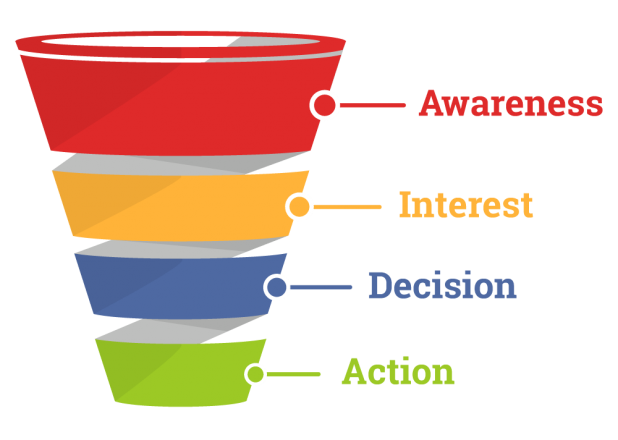
It’s rigid. It’s cold. Most of all, it’s inaccurate. There’s no room for your leads to be human, have human whims, and make nonsensical human purchasing decisions.
For example, on a real-life buyer’s journey, a person can flip from Awareness to Action in a split second. They may backtrack from Decision to Awareness. They’ll leap from Interest to Action. Thanks to the internet, buyers are more unpredictable than ever.
If you can’t predict where buyers will end up in the funnel from one moment to the next, what does that mean for your marketing? How will you craft content and messages that speak to where they stand?
Plus, the funnel completely ignores the concept of customer loyalty – a very buzzed-about topic in marketing these days, one that’s dominating most of the conversations in my marketing circles. Winning trust with buyers and building an ongoing relationship is starting to edge out the one-and-done sale, as CMI’s 2019 B2B research report demonstrates overall.
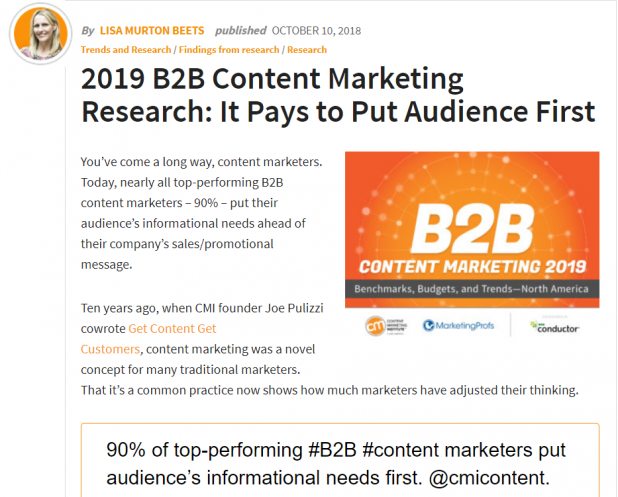
An audience-first mentality doesn’t mesh with the aggressive sales funnel and slimy, salesy tactics. That’s why we need a marketing lifecycle.
What is a Marketing Lifecycle?
The idea of lifecycle marketing has been out there for a while.
Ardath Albee, one of the leading voices in the industry, first talked about it on the Marketo blog:
“…winning a customer is only the first step of the journey to customer lifetime value (LTV). This is why it’s imperative for B2B tech marketers to shift their focus from buying journey funnels to full-on customer lifecycle management.”
The difference between a funnel and a lifecycle is pretty huge.
The sales funnel mentality is about that end-goal: The sale. Every action is meant to push the customer there. In sharp contrast, the end-goal of a marketing lifecycle is to build a relationship with the customer.
And, ultimately, that’s what most buyers these days want. They want to buy from trustworthy companies who offer amazing products/services and provide value in more ways than one. According to a 2018 Yotpo consumer survey, 90.2% of consumers consider themselves equally or more brand loyal than they were one year ago.
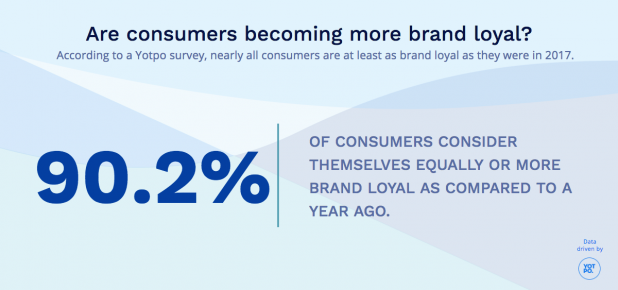
And, ultimately, a marketing lifecycle will help you provide what consumers want, no matter what stage of the buyer’s journey they’re standing in. Here’s what it looks like:
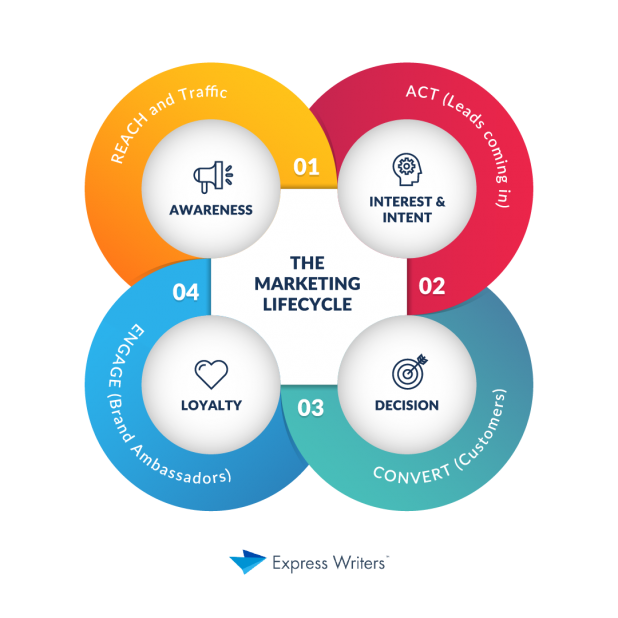
As you’ll notice, there are no walls in this chart. Rather, each stage is connected to every other stage through open pathways. As the buyer moves on their own unique path, you can connect with them with targeted techniques and content marketing.
So, what does that look like?
The 4 Stages of the Marketing Lifecycle
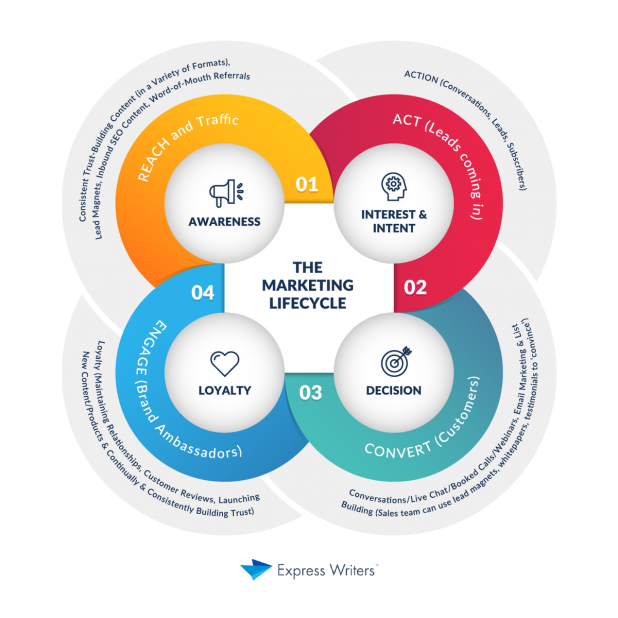
1. Awareness
In this stage, the buyer is aware of your brand. Pushy tactics will turn them off, especially overly-promotional pitches.
For buyers in awareness, you should create high-quality content that builds trust, builds community, and establishes your authority:
- Awesome SEO blogs
- Original research studies or round-ups
- Brand awareness blogs (real stories and pieces with creative, entertainment value)
- Web pages and guides
- Lead magnets, eBooks
- Social media content and videos
2. Interest/Intent
The buyer now has Interest in your brand with possible Intent to buy.
To build a relationship in this stage, real conversations with the buyer will have the most impact:
- Conversational marketing (live chat and phone calls with your best salespeople, messenger bots)
- A website that makes it easy to contact your team (clear CTAs, easy navigation and contact forms)
- Lead magnets, eBooks, webinars, and testimonials
- List-building and email marketing
- Retargeting campaigns
3. Decision
In the Decision stage, if you have answered their questions, provided value, and built trust, the buyer is ready to buy.
Now the buyer wants to see evidence that you can deliver:
- Following up and answering questions quickly
- Positive reviews on third-party sites
- Product demos, price quotes, or work samples
4. Loyalty
The Loyalty stage doesn’t exist in the sales funnel, but it’s critical for modern buyers.
Nurturing loyalty keeps your buyers in your marketing circle – eventually, these delighted customers can become brand evangelists. How?
- Great service and great products
- Regular follow-ups to touch base
- Thank-you gifts
- Email marketing with brand updates
- Fresh product/service releases
Forget the Funnel: It’s Time to Embrace the Marketing Lifecycle
Consumers today are savvier than ever. They have the miracle of the internet at their fingertips to help them make purchase decisions. They also want exceptional customer service.
It’s time to treat them like the humans they are – not numbers, not wallets, not figures on a line graph. If you are truly excited about making a difference with your marketing and appealing to today’s buyer, the marketing lifecycle is where it’s at.




